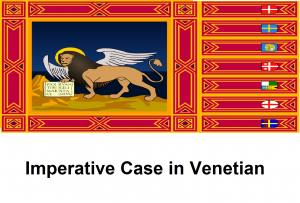Language/Venetian/Grammar/Imperative-Mood
The imperative mood is a grammatical mood that forms commands or requests, and it is widely used in everyday conversations in the Venetian language. In this lesson, we will explore the formation and usage of the imperative mood in Venetian, including its singular and plural forms, as well as some common irregular verbs.
Don't miss the chance to check out these pages as you wrap up this lesson: Imperative Tense, How to Use Have.
Regular Verbs[edit | edit source]
In Venetian, regular verbs are divided into three conjugations based on the infinitive ending: -ar, -er, and -ir. The imperative mood for regular verbs is formed by removing the infinitive ending and adding specific endings for the singular and plural forms.
a) -ar Verbs Example: parlar (to speak) Singular: parla (speak) Plural: parle (speak)
b) -er Verbs Example: vènder (to sell) Singular: vènd (sell) Plural: vendé (sell)
c) -ir Verbs Example: dormir (to sleep) Singular: dormi (sleep) Plural: dormì (sleep)
Negative Form[edit | edit source]
To make the imperative negative, add "no" before the verb. The negative form remains the same as the affirmative form.
Example: No parla (don't speak) No vènd (don't sell) No dormi (don't sleep)
Pronoun Attachment[edit | edit source]
When using pronouns with the imperative, attach the pronoun to the end of the verb. For example:
parla + ghe (to him/her) = parlaghe (speak to him/her) vènd + ło (it) = vèndło (sell it) dormi + con mi (with me) = dormiconmi (sleep with me)
Common Irregular Verbs[edit | edit source]
Some verbs in Venetian are irregular in the imperative mood. Here are a few examples:
èser (to be) Singular: sii (be) Plural: sié (be)
aver (to have) Singular: à (have) Plural: aé (have)
dar (to give) Singular: da (give) Plural: dè (give)
Polite Requests[edit | edit source]
To make a request more polite, you can add "par piaser" (please) at the end of the sentence.
Example: Parla con mi, par piaser (Speak with me, please)
Conclusion[edit | edit source]
In this lesson, we have learned how to form and use the imperative mood in Venetian grammar. Practice forming the imperative mood for various verbs and using it in different contexts to become more comfortable with the Venetian language.
Examples of Verbs in the Imperative Mood in Venetian[edit | edit source]
Verb : To speak (parlar / finishing by -ar)[edit | edit source]
| ENGLISH | PRONUNCIATION ENGLISH | VENETIAN |
|---|---|---|
| You speak !
(Singular) |
pahr lah | Parla ! |
| You speak !
(Plural) |
pahr leh | Parlé ! |
Verb : To drink (bévar / finishing by -ar) (stressed on the root)[edit | edit source]
| ENGLISH | PRONUNCIATION ENGLISH | VENETIAN |
|---|---|---|
| You drink !
(Singular) |
beh vih | Bévi |
| You drink !
(Plural) |
beh vih | Bévi |
Verb : To keep (tegner / finishing by -er)[edit | edit source]
| ENGLISH | PRONUNCIATION ENGLISH | VENETIAN |
|---|---|---|
| You keep !
(Singular) |
teh nyih | Tegni ! |
| You keep !
(Plural) |
teh nyih | Tegni ! |
Verb : To finish (finir / finishing by -ir)[edit | edit source]
| ENGLISH | PRONUNCIATION ENGLISH | VENETIAN |
|---|---|---|
| You finish !
(Singular) |
fih nih sih | Finisi ! |
| You finish !
(Plural) |
fih nih | Finì ! |
Negative form (use No before the verb)[edit | edit source]
| ENGLISH | PRONUNCIATION ENGLISH | VENETIAN |
|---|---|---|
| Don`t speak !
(Singular) |
noh
pahr lah |
No
parla ! |
| Don`t speak !
(Plural) |
noh
pahr leh |
No
parlé ! |
Other Lessons[edit | edit source]

